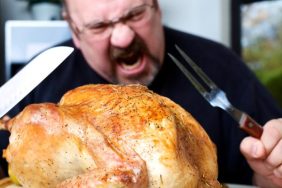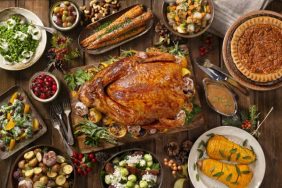
There’s a maxim in cooking that says the more effort and skill a dish requires, the better it’s going to taste, and a Thanksgiving turkey proves the rule. Admit it, it’s pretty rare to be bowled over by a bird that’s vacuum-sealed in bright white plastic, nestled into a yellow net, and spends several days thawing in your fridge. Organic, free-range turkeys are leagues better, but the cost can be significant. Pioneers, pilgrims, Native Americans and hunters of all stripes will tell you that for the real turkey experience, you’ll have to take matters into your own hands. (Photo credit: Vicki Deloach via Flickr CC)
Obtaining Your Turkey
The only legal way to obtain a wild turkey – other than paying someone to obtain it for you – is to get a hunting license and a weapon, and hit the trail. If the Apocalypse has happened, there are a number of ways to trap the birds, but if it hasn’t, you can really get yourself in hot water by not respecting the rules and regulations of your state; trapping birds is illegal in all 50. And as far as seasons, licenses, and firearms, do the research in advance; Fish and Game Department fines often involve more than money.

It’s worth remembering that turkeys are notoriously hard to hunt; even skilled hunters might only bag one or two per season, so it requires some patience. When the moment comes and you’re face-to-beak with a wild turkey, you want to aim the shotgun at its head and neck, otherwise you’ll find little metal pellets in the meat. If firearms are not to your taste, you can always try the seriously old-school method of bow and arrow. If you need a few tips and tricks about bow hunting, shoot Ted Nugent an email; he seems to be something of an expert. (Photo credit: Wisconsin Department of Natural Resources via Flickr CC)
Prepping Your Bird

Now that you’ve diminished the wild turkey population by a factor of one, there’s an unpleasantry to deal with: It’s impossible to avoid getting your hands dirty. Sure, you could hire someone to pluck and dress the bird, but that sort of messes up the effort/results maxim, doesn’t it? So, the first step is to hang the turkey up by its feet and, with a sharp knife, remove the head. Not only should the knife be sharp, it should be heavy and big. In fact, you might consider using an axe or hatchet, maybe a saw, and then hanging the turkey up by its feet. Let the blood drain from the bird once the head is gone. (Photo credit: Jon Pinder via Flickr CC)
Using a propane heater (check with your local hardware store) and a metal container big enough to hold the turkey, heat a quantity of water sufficient to submerge the bird into. Once the water is at or around 160 to 170 degrees, hold the turkey by its feet and plunge it in. Hold it under for about two minutes. Be forewarned: the scent of a large bird’s feathers being simmered is, to put it politely, singular. After two minutes are up, lay the bird on a flat surface and begin plucking the feathers. The big feathers are easy — it’s the little pin feathers that will drive you to distraction.

With your super-sharp knife, cut the feet away at the knee joint. You should now have a plucked and de-footed bird that looks something like a turkey you’d buy. But don’t go feeling a sense of satisfaction quite yet — the real fun is about to start. Lay the turkey on its back. Do you see the spot above the tail that looks like a small button? That’s the cloaca; the birds use it for laying eggs and excreting. With the point of your knife, cut around it in a circle and pull it out. You’ll want to stand back when you do this because the bird’s guts are going to come sliding forth in a gush. Discard them after they do. (Photo credit: State Farm via Flickr CC)

Use your knife to enlarge the hole and reach in. Feel around and start pulling out the organs — the heart, lungs, liver, etc. They may come out in one big gloppy pile, or you might have to really dig in with your fingers. You will probably notice that there’s a large deposit of green stuff under a membrane. It’s essential that this comes out unbroken. The whole thing is the bird’s bile sac and it will ruin the meat if it breaks. You can save the heart, liver, and gizzards — aka, the giblets — for making gravy or in a stuffing. (Photo credit: Maine.gov)

For the final step, you’ll want to wash the bird inside and out with a lot of cold water. You’re almost certain to find many sharp little barbs from feathers that didn’t get plucked cleanly. You can go at them with a pair of needle-nosed pliers. Some of the barbs might really give you some problems, but you’ve come this far and there’s no point finishing in a half-assed way so don’t give up. Once the bird is cleaned and washed, you can put it into the oven and get your turkey dinner going, but you’ll probably get the best flavor if you let it sit, refrigerated, overnight. (Photo credit: Berkeley.edu)

(Photo credit: Darren Pierson via Flickr CC)









